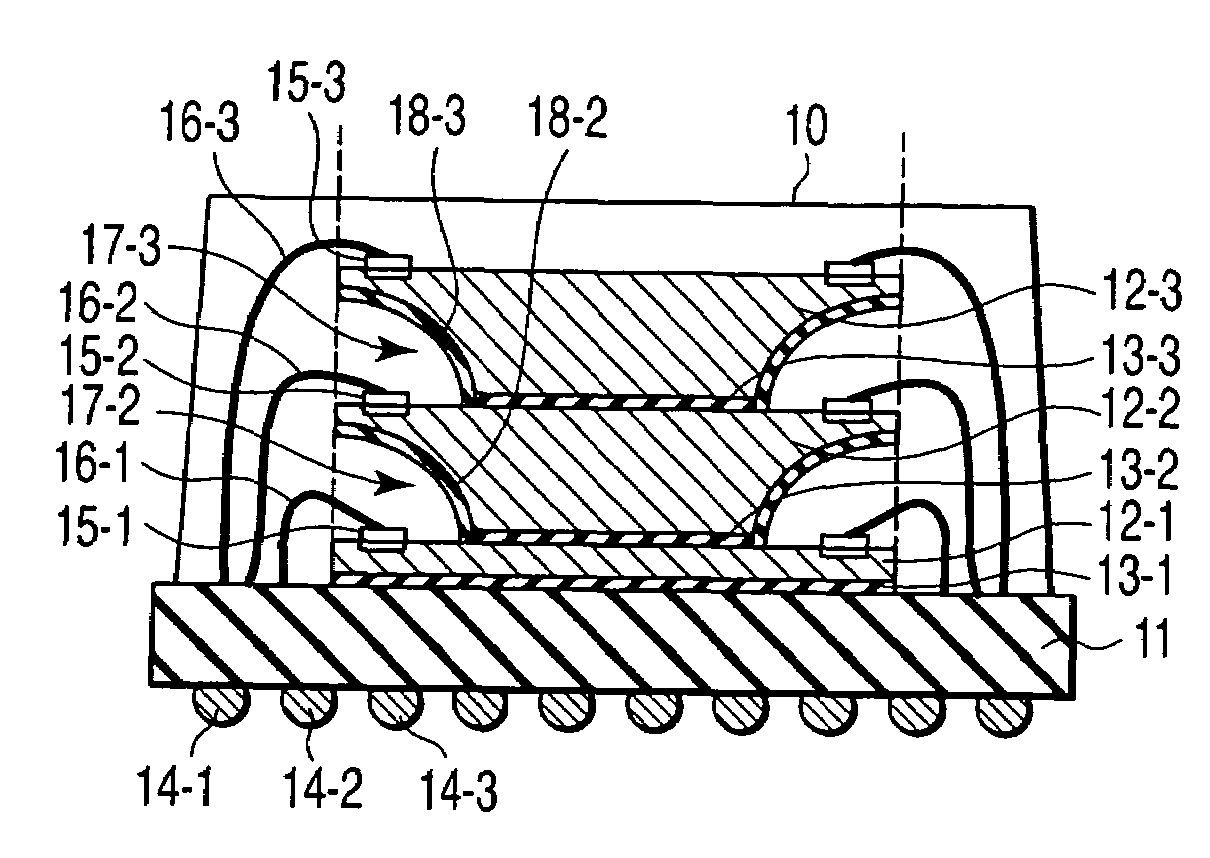Semiconductor device having semiconductor chips stacked and mounted thereon and manufacturing method thereof
a semiconductor chip and semiconductor technology, applied in semiconductor devices, semiconductor/solid-state device details, electrical devices, etc., can solve the problems of difficult to deal with the wafer, easy to crack or chip cracking, and easy to chip cracking
- Summary
- Abstract
- Description
- Claims
- Application Information
AI Technical Summary
Benefits of technology
Problems solved by technology
Method used
Image
Examples
first embodiment
[0168]FIG. 1 is a cross sectional view showing a semiconductor device according to a first embodiment of this invention. In this case, a stack MCP having three semiconductor chips with the same size stacked is dealt with as an example. That is, three semiconductor chips 12-1, 12-2, 12-3 with the same size are stacked and mounted on a printed circuit board (PCB) 11 with DAFs 13-1, 13-2, 13-3 disposed therebetween, respectively. For example, the circuit board 11 has a multi-layered wiring structure. Wirings to which bonding wires are connected are formed on the chip mounting surface of the circuit board 11 and external connection electrodes (external terminals) 14-1, 14-2, 14-3, . . . such as ball bumps (solder balls) and pins are arranged in an array form on the backside thereof to form a so-called ball grid array or pin grid array.
[0169]Bonding pads 15-1, 15-2, 15-3 formed on the main surfaces of the semiconductor chips 12-1, 12-2, 12-3 and the printed wirings formed on the chip mou...
second embodiment
[0355]FIG. 124 is a cross sectional view of a semiconductor device according to a second embodiment of this invention. In this case, a COC package type semiconductor device having three semiconductor chips with the same size stacked is taken as an example. Three semiconductor chips 12-1, 12-2, 12-3 with the same size are stacked and mounted on a circuit board 11 with DAFs (die attach films) 13-1, 13-2, 13-3 disposed therebetween, respectively. For example, the circuit board 11 has a multi-layered wiring structure. Electrode pads on which stud bumps 56-1 are formed are provided on the chip mounting surface of the circuit board 11 and external connection electrodes 14-1, 14-2, 14-3, . . . such as solder balls and pins are arranged in an array form on the backside of the chip to form a so-called ball grid array or pin grid array.
[0356]Through electrodes 55-1, 55-2, 55-3 formed of copper (Cu), gold (Au), tungsten (W) or polysilicon are provided along the two (or four) opposite sides of ...
PUM
 Login to View More
Login to View More Abstract
Description
Claims
Application Information
 Login to View More
Login to View More - R&D
- Intellectual Property
- Life Sciences
- Materials
- Tech Scout
- Unparalleled Data Quality
- Higher Quality Content
- 60% Fewer Hallucinations
Browse by: Latest US Patents, China's latest patents, Technical Efficacy Thesaurus, Application Domain, Technology Topic, Popular Technical Reports.
© 2025 PatSnap. All rights reserved.Legal|Privacy policy|Modern Slavery Act Transparency Statement|Sitemap|About US| Contact US: help@patsnap.com



